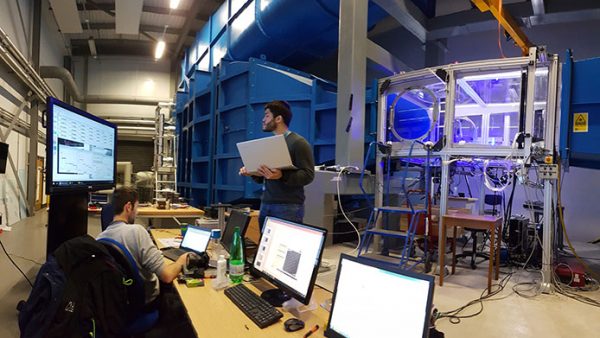Profile of SABRE Researcher – Andres Rivero Bracho
An interview with SABRE Team member Andres Rivero Bracho was written by Matt Bone for the Bristol Composites Institute Newsletter, University of Bristol – and is set out in full below.
Morphing Structures for Aerospace
What are morphing structures and what development challenges need to be overcome?
In the context of aerospace engineering, morphing refers to the ability of an aerostructure to change shape during operation, in a smooth and continuous way. Composite materials are commonly seen in morphing structures due to their anisotropic nature and tailorable properties. For example, variance in fibre direction can be used to increase stiffness in directions where load bearing is needed, while keeping the structure compliant in the direction where the change in shape occurs. A balance must be achieved between stiffness and compliance, so that the structure can sustain loads, while still being able to morph without needing a huge amount of energy: composite materials can help us reach this balance.
The main challenge on developing morphing structures is that they are inherently multi-disciplinary problems. There are different forces that interact with one another (i.e. structures, aerodynamics, actuation) which makes these structures difficult to model. Design and materials selection is very important as the structures must be manufacturable, both for testing and final application. In our research group, we do all these things ourselves. So, even though I don’t consider myself an expert on structural modelling, composites, aerodynamics or design & manufacture, I know a bit of everything and I’m constantly learning new things on each one of these topics.
Why use morphing structures in the aerospace industry?
Fixed-wing aircraft or rotorcraft must operate across a range of different conditions – temperatures, pressures, precipitation, altitudes, etc. – whilst performing different manoeuvres in a flight plan. Current aerostructures are designed to have a good performance during all flight stages. However, this leads to design compromise: in order to achieve a “good” performance in all conditions, the performance at each individual stage is far from optimal. This is where morphing structures become useful, because they can alter the wing geometry to achieve optimal performance at all times.
Hinged control surfaces – such as ailerons, flaps, elevator and rudder – seen on current on aircraft change the wing geometry in a sharp and discrete way, causing surface discontinuities and gaps. These discontinuities result in significant drag penalties, which is why flaps are normally used for control purposes only. By contrast, morphing wings change shape in a smooth and continuous way, without surface discontinuities, and subsequent drag penalty. Therefore, they can be used throughout flight to optimise wing geometry and reduce fuel consumption.
What is the aim of SABRE and how is the project progressing?
SABRE is a morphing structure project at Bristol that aims to develop adaptive rotor blades for helicopters. Bristol, along with several European partners, are developing different morphing structure concepts to improve the performance of helicopter rotor blades. The performance improvement should translate into a reduction in fuel consumption, with possible reductions in noise and vibration, for helicopters. The pandemic has made the project more challenging as the bulk of the modelling work is completed yet there is still much experimental work to tackle. With the project due to end in May, a lot of testing work is currently underway using the wind tunnel.
Can morphing concepts developed in SABRE be used in industrial applications?
Whilst these morphing concepts being developed in SABRE are not likely to see widespread commercial use in helicopters for some years, the technology may start commercial life by being incorporated in unmanned aerial vehicles (UAVs). UAVs have fewer risks, thus regulations are not as strict. Morphing devices may also have a future in wind turbine blade design, which could be an easier route to commercialise the concepts developed in SABRE.
Have you discovered anything new that you weren’t expecting to whilst conducting this research?
Yes, I learned that experiments are very difficult, and it is very likely that it will take you several attempts before you start getting useful data. For example, wind tunnel testing is a bit of an art, and getting it right requires a lot of experience, attention to detail, and trial and error. This can lead to lots of “ups” and “downs” across a project. While the ups define your work, the downs are what define your learning experience, so both are important.
